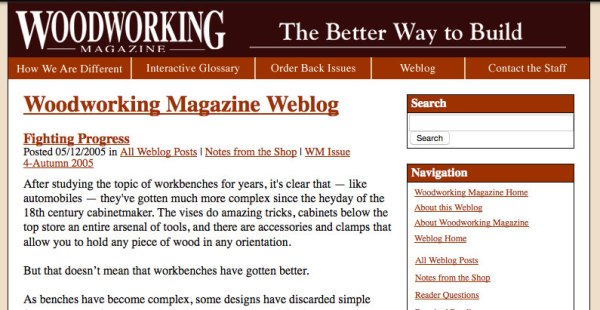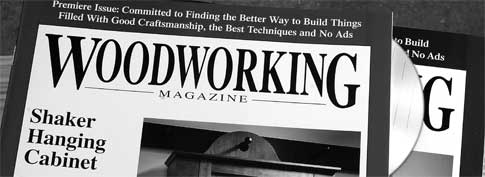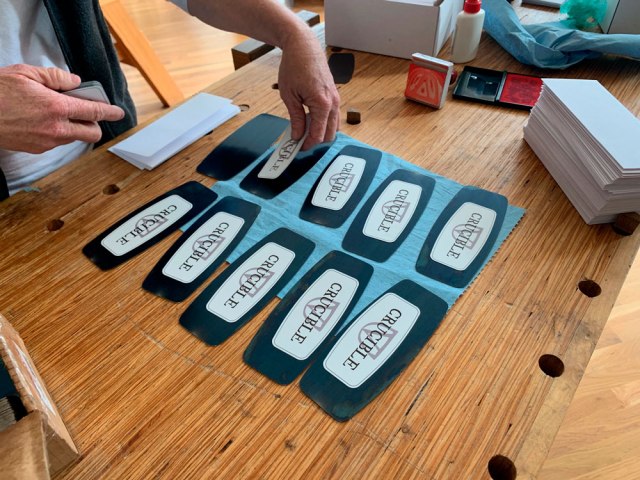10 Years of Fighting Progress –

I’m not one to celebrate or even acknowledge anniversaries, but this has been an odd year.
On four occasions this year I’ve had people approach me at woodworking shows or classes and say almost these exact words:
“I’d love to do what you do for a living, but I don’t have a magazine that will give me a blog with all the promotion you have.”
As a result, I feel the need to do something I rarely do: Set the record straight.
Exactly 10 years ago today I took the first steps toward writing a blog. I was a junior-level editor at Popular Woodworking and we had just launched Woodworking Magazine, an advertising-free publication that was aimed at investigating basic skills and exploring handwork.

Our parent company, F&W Media Inc., had indulged us and let us try a few issues as long as we didn’t spend any money on staff, manuscripts, illustrations or photography. After printing the first issue of Woodworking Magazine, I was driving home from a family event in Chicago and was wondering: How are we going to get people to read this magazine if we can only publish it once or twice a year?
Somewhere on I-65 I remembered my cousin, Jessamyn West. She was one of the first bloggers, though I didn’t really know what the word “blog” was. I thought her site was an online diary-thing.
What, I wondered, would happen if I did what Jess did but wrote about woodworking? Could it build an audience for the magazine? If readers liked what they read on the “weblog” they might buy the magazine on the newsstand.
After much arm-twisting (thanks to Steve Shanesy), I was granted an audience with our three “new media” guys during a lunch at the worst health-food store in the city. The head of new media was a part-time DJ on the weekends and had a blog that he used to document the raves and dances he worked. So he was the expert.
His question: “How are you going to get readers to pay for this blog?”
My answer: “We won’t. It will be free.”
Question: “You’re going to give away free content? You can’t afford to do that.”
Answer: “I know.”
Question: “So who is going to generate all this free content and keep people coming back every day or week?”
Answer: “I will.”
It took more than four months from that disgusting lunch to get a blog set up on our servers and connected to the fledgling web site for Woodworking Magazine. During those four months I wrote a lot of sample blog entries that proved it could be done (thank you, newspaper job).
The blog launched in May 2005 and has continued to this day. I don’t know (or really care) how many entries I’ve written; it’s easily more than 3,000. During the last 10 years, I can honestly say my blogs have not sucked up any advertising or promotion revenue on a budget line. Instead, they have generated money.
And that’s the point.
If you want to do this, you don’t need a magazine or a promotion budget. You don’t need to beg other bloggers to promote your work. If what you write is good, the work will promote itself. You don’t need SEO or SEM or Google AdSense. Screw all the stupid lists of things you need to do to promote your work. Don’t take free tools. Don’t take anything. Just give.
Write about stuff you care about. Write honestly. Write often. Don’t be afraid of what other people think. And don’t build your reputation by trampling your fellow craftsmen. A flaming a$$%ole will soon flame out.
If you do all those things above and some people hate you, that means you have struck a nerve. And it’s good to feel something. Most writing makes me feel nothing.
Below my sig is the first blog entry that appeared on the Woodworking Magazine weblog. As I read it now, it’s not my best work. But it’s not bad, for 2005. I can do better. And I will.
— Christopher Schwarz
Fighting Progress
Posted 05/12/2005 in All Weblog Posts | Notes from the Shop | WM Issue 4-Autumn 2005
After studying the topic of workbenches for years, it’s clear that — like automobiles — they’ve gotten much more complex since the heyday of the 18th century cabinetmaker. The vises do amazing tricks, cabinets below the top store an entire arsenal of tools, and there are accessories and clamps that allow you to hold any piece of wood in any orientation.
But that doesn’t mean that workbenches have gotten better.
As benches have become complex, some designs have discarded simple features that early woodworkers thought were essential. The tops became shorter and wider. This increased width makes it more difficult to clamp some work to the top and prevents you from working on long pieces (early workbenches could be up to 12′ long!). Aprons were added below the benchtop so you could use a thinner top. This apron gets in the way of some clamping operations.
The top was extended out over the legs, preventing you from clamping long boards, panels or doors securely to the front of the bench.
The handy storage cabinets below can interfere with basic clamping and jigging. Some vises, while more versatile, were made entirely of iron, which can damage your tools.
Among the myriad modern accessories, some have proven to be useful advancements while others are merely more expensive (but interesting) solutions to clamping problems that were once fixed by the humble and boring holdfast. The height of the bench was increased to get the work closer to your face, but this made some hand and power operations inefficient or unnecessarily tiring.
When we designed a workbench for Woodworking Magazine, it was on the principle that it should be only as complex as necessary, and no more. It had to hold our work for a wide variety of hand and power tool operations. And it had to be inexpensive, easy to build and easy to modify.
As luck would have it, that bench already exists. It was drawn by Andre Jacob Roubo in his landmark book “L’art du menuisier” (1769-1775) (Originals of this four-volume set are expensive. You can buy a reprint here: http://www.archambault.ca). So we gathered up all our old books and began sketching out the cover project for the September 2005 issue. Here’s what we’re thinking today: $32 in hardware, dimensional pine and traditional joints.
— Christopher Schwarz
Comments [0]




